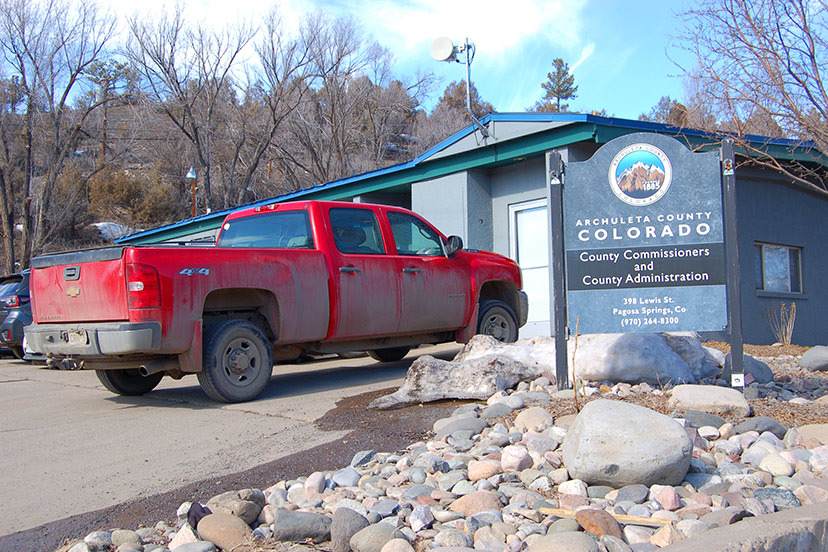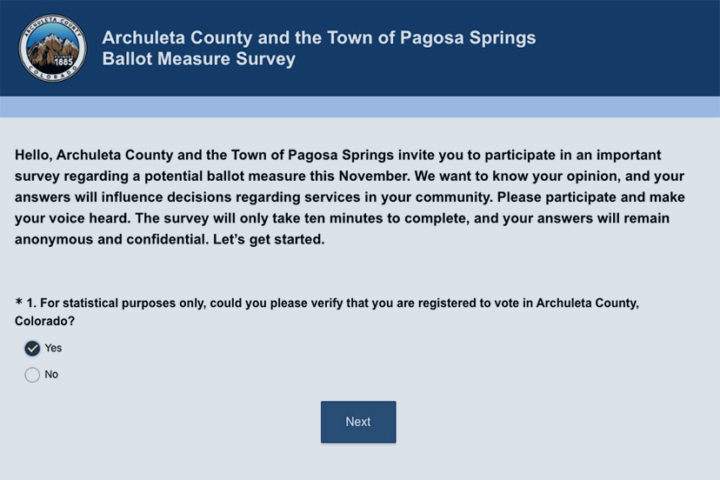PHOTO: The Archuleta County administrative offices, and a typical Pagosa Springs pickup truck.
Yesterday in Part One, I wrote briefly about an art event in Santa Fe, New Mexico — one of the many cities in the U.S. struggling with gentrification and the loss of housing for its workforce and its long-time “less wealthy” residents.
The story ought to ring a few bells for regular Daily Post readers. But the central story in this editorial series is playing out closer to home. “Home”, being Archuleta County, Colorado.
Last Tuesday, I missed a joint meeting hosted by the Archuleta County Board of County Commissioners (BOCC), to which they had invited the Pagosa Springs Town Council.
That same evening, August 16, I had attended the ‘Open House’ for the Pagosa Peak Open School, the only district-authorized, tuition-free charter school in Archuleta County. (I currently serve on the PPOS board of directors.) When I got home and logged into Zoom… the joint Town-County meeting had already ended.
The agenda for the meeting was fairly simple. The first item on the agenda was of particular interest to me, because I have an ongoing concern about government inefficiency and waste.
I. POTENTIAL SALES TAX BALLOT QUESTION RESULTS FROM MAGELLAN POLLING AND DISCUSSION ON NEXT STEPS
II. DISCUSSION ON PAGOSA AREA TOURISM BOARD SEATS AND POSSIBLE MOU AMENDMENT
III. OTHER ITEMS OF MUTUAL INTEREST
IV. NEXT MEETING DATE/LOCATION/TOPICS
Luckily, reporter Josh Pike from the weekly Pagosa Springs SUN newspaper attended the joint meeting and wrote up a summary of the government discussion. His article bore the headline: “Town, county move forward with sales tax ballot question”.
The joint Town-County discussion about the sales tax question focused mainly (according to Mr. Pike’s article) on a recent online survey conducted by Louisville, Colorado-based Magellan Strategies. The survey was jointly funded by the Town and County governments.
The BOCC is reportedly going to release the statistical results following this morning’s BOCC work session. Today, August 23.
Before we engage in a brief discussion about the survey results, I’d like to share a curious piece of writing I came across in a book entitled Amusing Ourselves to Death, written in 1985 by social commentator Neil Postman… and updated in 2005, two years before the release of the Apple iPhone.
I mention the iPhone because Mr. Postman’s book deals mainly with the various effects of communications technology. Something near and dear to my heart.
Mr. Postman was concerned with, among other things, the fact that most of what Americans call “news” has no significant impact on the way we actually live our daily lives. Most “news”, as delivered in the 21st century, is basically a form of entertainment, and almost never leads us into meaningful action.
From his book:
You may, of course, cast a ballot for someone who claims to have some plans, as well as the power to act. But this you can do only every two or four years by giving one hour of your time, hardly a satisfying means of expressing the broad range of opinions you hold. Voting, we might even say, is the next-to-last refuge of the politically impotent.
The last refuge is, of course, giving your opinion to a pollster, who will get a version of it through a desiccated question, and will submerge it in a Niagara of similar opinions, and convert them into — what else? — another piece of news.
Thus, we have here a a great loop of impotence: the news elicits from you a variety of opinions about which you can do nothing except to offer them as more news [to your friends and family]…
This is certainly true about most of what we now consider ‘news’, because 99% of ‘news’ — as delivered via TV, social media, magazines, national media — has very little to do with the actual community in which we live and play out our lives.
This is not so true, however, about local news media like the weekly Pagosa Springs SUN, which consists almost entirely of ‘local news’ about what’s happening in our community — and about events and public meetings in which we can participate, if we so desire.
Both the SUN and the Daily Post published stories about the above-mentioned Magellan Strategies survey, for example… and may have helped generate public participation in that survey. According to Mr. Pike’s article, about 1,100 people participated in the survey, which is a decent turnout in a town of 14,000.
How many of those responses came from local taxpayers is not yet clear to me. But I hope to find out more about who participated, when the County government releases the data. (Today?)
Here’s a couple of short excerpts from Mr. Pike’s SUN article, published last Thursday.
The next question asked whether respondents would vote for or against a 1.5 percent sales tax increase, which would generate approximately $3.263 million of new revenue for the town and county each.
According to [Archuleta County Manager Derek Woodman], 52 percent of respondents indicated they would vote yes to this increase while 41 percent indicated they would vote no — a result he described as “very promising.”
We might want to consider that this survey was not sponsored by a disinterested party, but by two government entities that have, over that past couple of months, expressed a unified goal of acquiring more tax revenues from Pagosa Springs taxpayers.
We might also want to consider that the County government employs about 160 people, and may have encouraged their employees — and their families — to participate in the survey.
Ditto the Town government, with maybe 40 employees and their families?
It’s conceivable that a quarter of the voters who participated in the Magellan survey have a vested interest in a sales tax increase. But we probably won’t ever know how many government employees answered the survey, because — apparently — Magellan didn’t track that sort of thing.
If indeed a large number of County and Town employees and their families responded favorably to the sales tax increase survey… then perhaps the “52% Would Vote Yes” number means relatively little…
Mr. Pike also noted that County Manager Derek Woodman delivered some “bad news” during last Tuesday’s joint meeting.
Woodman then moved on to discussing the “bad news,” which was that, statutorily, county government could only have a maximum sales tax of 4.2 percent, a restriction rendering the sales tax increase as proposed impossible.
The County already collects a 4% sales tax. Have the Town and County spent the past two months discussing a sales tax increase that is not even allowable under Colorado law?


